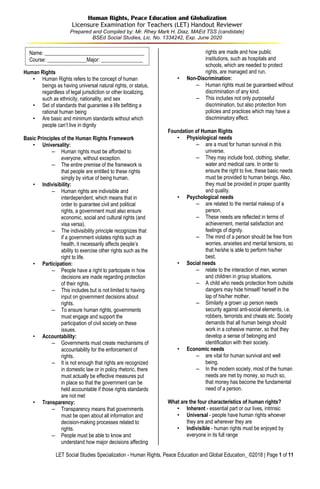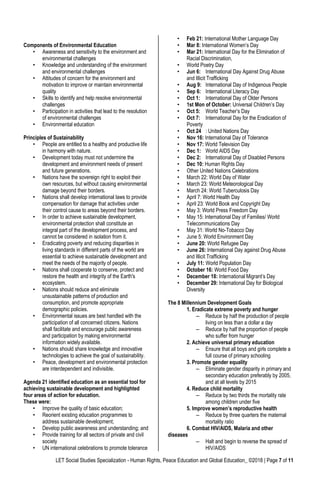The document discusses key concepts related to human rights, peace education, and globalization. It covers the following main points:
1. It defines human rights and outlines the basic principles of universality, indivisibility, participation, accountability, transparency, and non-discrimination that form the framework of human rights.
2. It discusses the classification of human rights according to their nature, recipient, source, and implementation. It also examines the foundation of human rights in terms of physiological, psychological, social, and economic needs.
3. It covers children's rights as defined by the Convention on the Rights of the Child, including their rights to survival, participation, protection, and development.
4.


![LET Social Studies Specialization - Human Rights, Peace Education and Global Education_ ©2018 | Page 3 of 11
– Art.10 – right to family reunification
– Art.11 – protection from illicit transfer and
non-return
– Art.16 – right to privacy
– Art.19 – protection from abuse and
neglect
– Art.20 – protection of children without
families
– Art.21 – right to be adopted
– Art.22 – right of child refugees to special
care and protection
– Art.23 – right of children with disabilities
to special care
– Art.40 – right to juvenile justice
• Development rights – things children need to
reach their fullest adequate standard of living
– Art.28 and 29 – right to education
– Art.31 – right to play, leisure and
recreation
– Art.31 – participation in cultural activities
– Art.5 – right to parental guidance
– Art.6 – right to life and development
– Art.7 – right to a name and nationality
– Art.9 – right to live with parents
– Art.10 – right to family reunification
– Art.11 – protection from illicit transfer and
non-return
– Art.12 – right to respect for one’s views
– Art.13 – freedom of expression
– Art.14 – freedom of thought, conscience
and religion
– Art.15 – freedom of association
– Art.17 – right to information
– Art.24 – right to health and health
services
– Art.26 – right to social security
– Art.27 – right to adequate standard of
living
Citizenship Education
• Civics education
– can be defined as educating children,
from early childhood, to become clear-
thinking and enlightened citizens who
participate in decisions concerning
society.
– is based on the distinction between the
individual, a subject of ethics and law,
entitled to all the rights inherent in the
human condition –
– that is, human rights- and the citizen,
entitled to civic rights, that is to say, the
civil and political rights recognized by the
national constitution of the country
concerned
Objectives of Citizenship/Civics Education
• educating people in citizenship and human rights
through an understanding of the principles and
institutions [which govern a state or nation];
• learning to exercise one’s judgment and critical
faculty;
• acquiring a sense of individual and community
responsibilities
Qualities of a Good Citizen
• effective citizens who act out of respect for the
common good; willing to deliberate about the
nature of public good and how to achieve it
• Understand and are committed to the following
values inherent in the Constitution and Bill of
Rights:
Justice
- Freedom
- Participation
- Equality
- Diversity
- Truth
- Authority
- Due process
- Patriotism
- Human Rights
- Rule of Law
- Tolerance
• Personal and Civic Responsibility Self Respect
• Possess the values of compassion, ethical
commitment. social responsibility and a sense of
interdependence among people and between
people and their environment
Components of Civics Education
• Civic knowledge and understanding
– The set of relevant knowledge conceived
as the proper foundation of civic virtue
and participation. Civic knowledge
includes:
– the history of one’s country and its
relation with other countries of the world,
– the structuring and functioning of the
government and the state in a democratic
society,
– the principles governing democracy
including law and rights, duties and
obligations of both the state and the
individuals,
– current issues and problems.
– Civic knowledge addresses this
question: what should the citizen
ideally know in order to be an effective
citizen?
• Civic intellectual / Participatory Skills. These
include:
– Skills in higher level thinking processes –
critical reasoning, problem solving,
decision making, perspective taking,
divergent thinking, constructing
hypotheses and evaluating evidences
– Social skills identified as critical for high
functioning citizens such as:
Communication skills, Conflict
management and conflict resolution skills,
Consensus building, Problem solving and
decision making
• Civic Values and Disposition](https://image.slidesharecdn.com/handouthuman-rights2018-edition-180623022735/85/Handout-human-rights-2018-edition-3-320.jpg)







